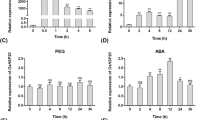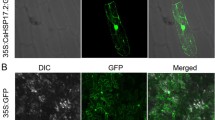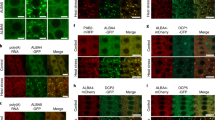Abstract
Abiotic stress may result in protein denaturation. To confront protein inactivation, plants activate protective mechanisms that include chaperones and chaperone-like proteins, and low-molecular weight organic molecules, known as osmolytes or compatible solutes. If these protective processes fail, the irreversibly damaged proteins are targeted for degradation. Tomato ASR1 (SlASR1) is encoded by a plant-specific gene. Steady state levels of transcripts and protein are transiently induced by salt and water stress in an ABA-dependent manner. SlASR1 is localized in both the cytosol as unstructured monomers and in the nucleus as structured DNA-bound dimers. We show here that the unstructured form of SlASR1 has chaperone-like activity and can stabilize a number of proteins against denaturation caused by heat and freeze-thaw cycles. The protective activity of SlASR1 is synergistic with that of the osmolyte glycine-betaine, which accumulates under stress conditions. We suggest that the cytosolic pool of ASR1 protects proteins from denaturation.




Similar content being viewed by others
Abbreviations
- ANS:
-
1-Anilinonaphthalene-8-sulphonate
- ASR1:
-
Abscisic acid stress ripening 1
- BSA:
-
Bovine serum albumin
- CS:
-
Porcine muscle citrate synthase
- DTT:
-
Dithiothreitol
- Hsp:
-
Heat shock proteins
- LDH:
-
Rabbit muscle lactate dehydrogenase
- LEA:
-
Late embryogenesis abundant
- SlASR1:
-
Tomato ASR1
References
Amitai-Zeigerson H, Scolnik PA, Bar-Zvi D (1995) Tomato Asr1 messenger-RNA and protein are transiently expressed following salt stress, osmotic stress and treatment with abscisic acid. Plant Sci 110:205–213
Ashraf M, Foolad MR (2007) Roles of glycine betaine and proline in improving plant abiotic stress resistance. Environ Exp Bot 59:206–216
Bohnert HJ, Shen B (1999) Transformation and compatible solutes. Sci Hort 78:237–260
Bourot S, Sire O, Trautwetter A, Touze T, Wu LF, Blanco C, Bernard T (2000) Glycine betaine-assisted protein folding in a lysA mutant of Escherichia coli. J Biol Chem 275:1050–1056
Cakir B, Agasse A, Gaillard C, Saumonneau A, Delrot S, Atanassova R (2003) A grape ASR protein involved in sugar and abscisic acid signaling. Plant Cell 15:2165–2180
Caldas T, Demont-Caulet N, Ghazi A, Richarme G (1999) Thermoprotection by glycine betaine and choline. Microbiology 145:2543–2548
Carpenter JF, Crowe JH (1988) The mechanism of cryoprotection of proteins by solutes. Cryobiology 25:244–255
Carrari F, Fernie AR, Iusem ND (2004) Heard it through the grapevine? ABA and sugar cross-talk: the ASR story. Trends Plant Sci 9:57–59
Chen THH, Murata N (2002) Enhancement of tolerance of abiotic stress by metabolic engineering of betaines and other compatible solutes. Curr Opin Plant Biol 5:250–257
Diamant S, Eliahu N, Rosenthal D, Goloubinoff P (2001) Chemical chaperones regulate molecular chaperones in vitro and in cells under combined salt and heat stresses. J Biol Chem 276:39586–39591
Diamant S, Rosenthal D, Azem A, Eliahu N, Ben-Zvi AP, Goloubinoff P (2003) Dicarboxylic amino acids and glycine-betaine regulate chaperone-mediated protein-disaggregation under stress. Mol Microbiol 49:401–410
Ellis RJ (2006) Molecular chaperones: assisting assembly in addition to folding. Trends Biochem Sci 31:395–401
Eom JW, Baker WR, Kintanar A, Wurtele ES (1996) The embryo-specific EMB-1 protein of Daucus carota is flexible and unstructured in solution. Plant Sci 115:17–24
Frankel N, Nunes-Nesi A, Balbo I, Mazuch J, Centeno D, Iusem ND, Fernie AR, Carrari F (2007) ci21A/Asr1 expression influences glucose accumulation in potato tubers. Plant Mol Biol 63:719–730
Garay-Arroyo A, Colmenero-Flores JM, Garciarrubio A, Covarrubias AA (2000) Highly hydrophilic proteins in prokaryotes and eukaryotes are common during conditions of water deficit. J Biol Chem 275:5668–5674
Goldgur Y, Rom S, Ghirlando R, Shkolnik D, Shadrin N, Konrad Z, Bar-Zvi D (2007) Desiccation and zinc binding induce transition of tomato abscisic acid stress ripening 1, a water stress- and salt stress-regulated plant-specific protein, from unfolded to folded state. Plant Physiol 143:617–628
Goyal K, Tisi L, Basran A, Browne J, Burnell A, Zurdo J, Tunnacliffe A (2003) Transition from natively unfolded to folded state induced by desiccation in an anhydrobiotic nematode protein. J Biol Chem 278:12977–12984
Goyal K, Walton LJ, Tunnacliffe A (2005) LEA proteins prevent protein aggregation due to water stress. Biochem J 388:151–157
Hara M, Terashima S, Kuboi T (2001) Characterization and cryoprotective activity of cold-responsive dehydrin from Citrus unshiu. J Plant Physiol 158:1333–1339
Incharoensakdi A, Takabe T, Akazawa T (1986) Effect of betaine on enzyme activity and subunit interaction of ribulose-1,5-bisphosphate carboxylase oxygenase from Aphanothece halophytica. Plant Physiol 81:1044–1049
Kalifa Y, Gilad A, Konrad Z, Zaccai M, Scolnik PA, Bar-Zvi D (2004a) The water- and salt-stress-regulated Asr1 (abscisic acid stress ripening) gene encodes a zinc-dependent DNA-binding protein. Biochem J 381:373–378
Kalifa Y, Perlson E, Gilad A, Konrad Z, Scolnik PA, Bar-Zvi D (2004b) Over expression of the water and salt stress-regulated Asr1 gene confers an increased salt tolerance. Plant Cell Environ 27:1459–1468
Lee S, Tsai FTF (2005) Molecular chaperones in protein quality control. J Biochem Mol Biol 38:259–265
Lin CT, Thomashow MF (1992) A cold-regulated Arabidopsis gene encodes a polypeptide having potent cryoprotective activity. Biochem Biophys Res Commun 183:1103–1108
Lisse T, Bartels D, Kalbitzer HR, Jaenicke R (1996) The recombinant dehydrin-like desiccation stress protein from the resurrection plant Craterostigma plantagineum displays no defined three-dimensional structure in its native state. Biol Chem 377:555–561
Maskin L, Frankel N, Gudesblat G, Demergasso MJ, Pietrasanta LI, Iusem ND (2007) Dimerization and DNA-binding of ASR1, a small hydrophilic protein abundant in plant tissues suffering from water loss. Biochem Biophys Res Commun 352:831–835
Mcneil SD, Nuccio ML, Hanson AD (1999) Betaines and related osmoprotectants. Targets for metabolic engineering of stress resistance. Plant Physiol 120:945–949
Momma M, Kaneko S, Haraguchi K, Matsukura U (2003) Peptide mapping and assessment of cryoprotective activity of 26/27-kDa dehydrin from soybean seeds. Biosci Biotechnol Biochem 67:1832–1835
Mouillon JM, Gustafsson P, Harryson P (2006) Structural investigation of disordered stress proteins. Comparison of full-length dehydrins with isolated peptides of their conserved segments. Plant Physiol 141:638–650
Pollard A, Wynjones RG (1979) Enzyme activities in concentrated solutions of glycine betaine and other solutes. Planta 144:291–298
Reyes JL, Rodrigo MJ, Colmenero-Flores JM, Gil JV, Garay-Arroyo A, Campos F, Salamini F, Bartels D, Covarrubias AA (2005) Hydrophilins from distant organisms can protect enzymatic activities from water limitation effects in vitro. Plant Cell Environ 28:709–718
Rhodes D, Hanson aD (1993) Quaternary ammonium and tertiary sulfonium compounds in higher plants. Annu Rev Plant Physiol Plant Mol Biol 44:357–384
Rom S, Gilad A, Kalifa Y, Konrad Z, Karpasas MM, Goldgur Y, Bar-Zvi D (2006) Mapping the DNA- and zinc-binding domains of ASR1 (abscisic acid stress ripening), an abiotic-stress regulated plant specific protein. Biochimie 88:621–628
Roychaudhuri R, Sarath G, Zeece M, Markwell J (2003) Reversible denaturation of the soybean Kunitz trypsin inhibitor. Arch Biochem Biophys 412:20–26
Santhoshkumar P, Sharma KK (2001) Analysis of alpha-crystallin chaperone function using restriction enzymes and citrate synthase. Mol Vis 7:172–177
Semisotnov GV, Rodionova Na, Razgulyaev OI, Uversky VN, Gripas aF, Gilmanshin RI (1991) Study of the molten globule intermediate state in protein folding by a hydrophobic fluorescent probe. Biopolymers 31:119–128
Shearstone JR, Baneyx F (1999) Biochemical characterization of the small heat shock protein IbpB from Escherichia coli. J Biol Chem 274:9937–9945
Smulders RHPH, Carver JA, Lindner RA, vanBoekel MAM, Bloemendal H, deJong WW (1996) Immobilization of the C-terminal extension of bovine alpha A-crystallin reduces chaperone-like activity. J Biol Chem 271:29060–29066
Soulages JL, Kim K, Arrese EL, Walters C, Cushman JC (2003) Conformation of a group 2 late embryogenesis abundant protein from soybean. Evidence of poly (l-proline)-type II structure. Plant Physiol 131:963–975
Stryer L (1965) The interaction of a naphthalene dye with apomyoglobin and apohemoglobin. A fluorescent probe of non-polar binding sites. J Mol Biol 13:482–495
Subbian E, Yabuta Y, Shinde UP (2005) Folding pathway mediated by an intramolecular chaperone: intrinsically unstructured propeptide modulates stochastic activation of subtilisin. J Mol Biol 347:367–383
Tompa P (2005) The interplay between structure and function in intrinsically unstructured proteins. FEBS Lett 579:3346–3354
Tompa P, Csermely P (2004) The role of structural disorder in the function of RNA and protein chaperones. FASEB J 18:1169–1175
Vessel ES, Yielding KL (1966) Effects of pH, ionic strength, and metabolic intermediates on the rates of heat inactivation of lactate dehydrogenase isosymes. Proc Natl Acad Sci USA 56:1317–1324
Wang WX, Vinocur B, Shoseyov O, Altman A (2004) Role of plant heat-shock proteins and molecular chaperones in the abiotic stress response. Trend Plant Sci 9:244–252
Wisniewski M, Webb R, Balsamo R, Close TJ, Yu XM, Griffith M (1999) Purification, immunolocalization, cryoprotective, and antifreeze activity of PCA60: a dehydrin from peach (Prunus persica). Physiol Plant 105:600–608
Yancey PH (2005) Organic osmolytes as compatible, metabolic and counteracting cytoprotectants in high osmolarity and other stresses. J Exper Biol 208:2819–2830
Yancey PH, Clark ME, Hand SC, Bowlus RD, Somero GN (1982) Living with water stress—evolution of osmolyte systems. Science 217:1214–1222
Yang CY, Chen YC, Jauh GY, Wang CS (2005) A lily ASR protein involves abscisic acid signaling and confers drought and salt resistance in Arabidopsis. Plant Physiol 139:836–846
Author information
Authors and Affiliations
Corresponding author
Rights and permissions
About this article
Cite this article
Konrad, Z., Bar-Zvi, D. Synergism between the chaperone-like activity of the stress regulated ASR1 protein and the osmolyte glycine-betaine. Planta 227, 1213–1219 (2008). https://doi.org/10.1007/s00425-008-0693-5
Received:
Accepted:
Published:
Issue Date:
DOI: https://doi.org/10.1007/s00425-008-0693-5




